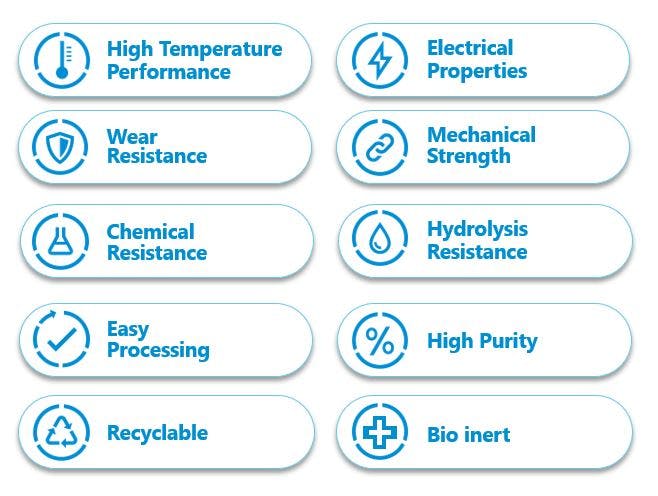Tribology guide: How PEEK polymers deliver superior wear resistance in high-friction applications
Did you know that a staggering 23% of the world’s energy consumption in the four main energy-consuming sectors (transportation, manufacturing, power generation, and residential) results from losses due to friction and wear. If even half that could be overcome, that would reduce CO2 emissions annually by 3.8 billion tonnes.
Friction results in the generation of heat at the expense of kinetic energy of motion – in other words, the energy applied to make things move is lost as heat through friction, resulting in increased energy consumption, fuel use and CO2 emissions to maintain that motion. Worn-out components must be replaced with new ones, consuming more materials, leading to machine downtime, reduced efficiency, increased running costs, loss of reliability and more energy use.
Traditional materials such as metals have been used in these applications but using alternative materials, surfaces and lubricants could reduce this by 20% to 40%. Whilst the largest opportunities are in transportation and energy generation, the savings in manufacturing and residential are also significant. So the motivation to minimise friction and wear to reduce energy use is clear. And that’s where Victrex materials can help.
History and Definitions: Tribology, Friction, Lubrication & Wear
-
Tribology:
The term “tribology” was first used in the 1960’s but derives from the Greek “tribo” meaning “rub”, and “logia” meaning “the study of”, and can be defined as the study of friction, lubrication and wear.
-
Friction
is the force resisting the motion of two surfaces moving against one another: friction converts the energy of motion into heat energy. Humankind developed a basic understanding of friction in prehistoric times with the discovery that fire could be created by rubbing two pieces of wood together.
-
Lubricant:
A lubricant is a substance capable of reducing friction and hence heat and wear when introduced as a film between moving solid surfaces. Like friction, lubricants are nothing new, dating back as far as ~3,500BC, for example, specimens taken from Egyptian chariots dated to 1,400BC show that tallow was used to grease the axles of these chariots.
-
Wear:
Wear is simply the damage caused by something being used a lot or for a long time, making it thinner or weaker or causing it to fail.
It took until 1493 for quantitative studies of friction to be carried out by Leonardo da Vinci, but his findings went unpublished. They were rediscovered in 1699 by Guillaume Amontons who noted that:
- The force of friction is directly proportional to the applied load;
- The force of friction is independent of the apparent area of contact.
These “laws” apply to a wide range of systems even today. Consider a block of VICTREX PEEK moving across a surface at a constant velocity:

We can see that:
- The Applied Force is equal (in magnitude) and opposite (in direction) to the Friction Force (that’s why the velocity is constant);
- Similarly, the Weight of the block is equal and opposite to the Normal Force exerted by the grey surface (if it wasn’t the block would sink into the surface or float away);
- The lower the Weight and hence the Normal Force, N, the lower the Friction Force, F. The lower the friction force, the lower the heat generation.
Notice that the equation says nothing about the temperature, contact surface area, mechanical properties, or roughness of the load or the surface on which it is moving.
Much of our understanding of tribology was developed in the second half of the 20th century (hence the late introduction of the term “tribology”) by Bowden and Tabor and latterly by Neale. We’ll explore the technical aspects of friction, wear and lubrication in future blogs, so watch this space.
Why are PEEKs resistant to friction and wear?
As I mentioned in a previous blog, VICTREX PEEK high-performance polymer materials have a unique combination of attractive properties: a number of these underpin these materials’ high friction and wear resistance.
All Victrex materials have high heat resistance, with glass transition temperatures exceeding 140°C and continuous use temperatures of typically 260°C, so can resist some of the heat generated by friction.

Intrinsic high mechanical strength serves to augment this performance, particularly when VICTREX PEEK polymers are modified with additives to further enhance high temperature performance and to reduce the coefficient friction.
In some products, we add carbon fibre to the polymer for additional strength, especially at high temperatures; and we may add fluoropolymers, graphite and other additives to reduce the coefficient of friction of the material.
To a first approximation then:
Reduced friction = reduced heat generation = reduced wear = reduced energy consumption + longer component lifetime.
Finally, in those applications where lubricants are used, Victrex PEEK-based materials offer excellent chemical resistance, even in environments where elevated temperatures and pressures are experienced. This combination of properties may make VICTREX PEEK materials an ideal choice when friction, heat, wear and energy losses need to be minimised.
About the author
John Grasmeder, Chief scientist at Victrex
Dr John Grasmeder has over 25 years’ experience in the polymer industry, in R&D, commercial and business leadership positions at ICI, BASF, Hoechst and Shell joint ventures in both the UK and Germany. He has been with Victrex 11 years, and was Technical Director from 2010. He became Chief Scientist in 2016.
About the author




